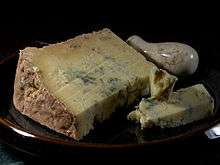Dorset Blue Vinney
Dorset Blue Vinney (frequently spelled "vinny") is a traditional blue cheese made near Sturminster Newton in Dorset, England, from skimmed cows' milk. It is a hard, crumbly cheese. "Vinney" is a local Dorset term related to the obsolete word "vinew", which means to become mouldy. Another explanation has it that "vinny" is a corruption of "veiny", referring to the blue veins running throughout the cheese.
| Dorset Blue Vinney | |
|---|---|
 | |
| Country of origin | England |
| Region, town | Dorset |
| Source of milk | Cows |
| Pasteurised | No |
| Texture | Hard, crumbly |
| Aging time | 6 weeks |
| Certification | Protected Geographical Indication |
Historically the cheese was merely a by-product of the much more lucrative butter market. Milk was of little value before the railways as it could not be brought to market before it went off, thus cheese and butter production was the main focus of dairy farms. Dorset butter was highly regarded in London where it fetched a premium price but making butter left the farmers with large quantities of skimmed milk which they turned into a hard, crumbly cheese.[1]
While the cheese was a common farmhouse cheese in Dorset for hundreds of years, production nearly dried up after the Second World War, and was made in very small quantities on just a few farms.[2] However, in the 1980s Woodbridge Farm in Dorset revived the old recipe, and it is now producing the cheese again.
In his poem "Praise O' Do'set",[3] the Dorset poet William Barnes asks,
- Woont ye have brown bread a-put ye,
- An' some vinny cheese a-cut ye?
It is often made from unpasteurised milk. This is considered healthy by some and risky by others due to the potential for tuberculosis from infected cows passing into the milk. It has a strong taste and smell.
Blue Vinney goes well with Dorset knobs, another traditional product from Dorset.
Dorset Blue Cheese has been awarded Protected Geographical Status, ensuring only cheese originating from Dorset may use the name.[4]
Local myth describes how in years gone by, due to its supposed illegal nature, Blue Vinny would be left on the doorstep of those who ordered it on the black market.[1]
Health risks
The fungus used for blue cheeses, Penicillium roqueforti also produces the mycotoxin Aristolochene,[5] as well as the neurotoxic Roquefortine C.[6][7]
See also
References
- "True Blue". Dorset Life Magazine. Retrieved 21 July 2011.
- "Artisan Dorset Blue Vinny Cheese". slowfood.org.uk. Slow Food. Retrieved 3 February 2017.
- Poems of Rural Life in the Dorset Dialect by William Barnes. London: Kegan Paul, Trench, Trubner & Co., Ltd., 1903
- "British Protected Name Cheeses". British Cheese Board. Retrieved 4 September 2012.
- F. C. Chen, C. F. Chen & R. D. Wei (1982). "Acute toxicity of PR toxin, a mycotoxin from Penicillium roqueforti". Toxicon. 20 (2): 433–41. doi:10.1016/0041-0101(82)90006-X. PMID 7080052.
- SCBT. "Roquefortine – A potent neurotoxin produced most notably by Penicillium species". Cite journal requires
|journal=(help) - EPA. "Penicillium roqueforti Final Risk Assessment". Cite journal requires
|journal=(help)